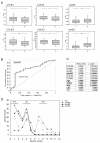Deoxysphingoid bases as plasma markers in diabetes mellitus
- PMID: 20712864
- PMCID: PMC2931514
- DOI: 10.1186/1476-511X-9-84
Deoxysphingoid bases as plasma markers in diabetes mellitus
Abstract
Background: Sphingoid bases are formed from the precursors L-serine and palmitoyl-CoA-a reaction which is catalyzed by the serine-palmitoyltransferase (SPT). SPT metabolizes, besides palmitoyl-CoA also other acyl-CoAs but shows also variability towards the use of other amino acid substrates. The enzyme is also able to metabolize alanine, which results in the formation of an atypical deoxy-sphingoid base (DSB). This promiscuous activity is greatly increased in the case of the sensory neuropathy HSAN1, and pathologically elevated DSB levels have been identified as the cause of this disease. Clinically, HSAN1 shows a pronounced similarity to the diabetic sensory neuropathy (DSN), which is the most common chronic complication of diabetes mellitus. Since serine and alanine metabolism is functionally linked to carbohydrate metabolism by their precursors 3-phosphoglycerate and pyruvate, we were interested to see whether the levels of certain sphingoid base metabolites are altered in patients with diabetes.
Results: In a case-control study we compared plasma sphingoid base levels between healthy and diabetic individuals. DSB levels were higher in the diabetic group whereas C16 and C18 sphingoid bases were not significantly different. Plasma serine, but not alanine levels were lower in the diabetic group. A subsequent lipoprotein fractionation showed that the DSBs are primarily present in the LDL and VLDL fraction.
Conclusion: Our results suggest that DSBs are a novel category of plasma biomarkers in diabetes which reflect functional impairments of carbohydrate metabolism. Furthermore, elevated DSB levels as we see them in diabetic patients might also contribute to the progression of the diabetic sensory neuropathy, the most frequent complication of diabetes.
Figures


References
-
- Penno A, Reilly MM, Houlden H, Laura M, Rentsch K, Niederkofler V, Stoeckli ET, Nicholson G, Eichler F, Brown RH Jr. et al. Hereditary sensory neuropathy type 1 is caused by the accumulation of two neurotoxic sphingolipids. J Biol Chem. 2010;285(15):11178–11187. doi: 10.1074/jbc.M109.092973. - DOI - PMC - PubMed
-
- Zitomer NC, Mitchell T, Voss KA, Bondy GS, Pruett ST, Garnier-Amblard EC, Liebeskind LS, Park H, Wang E, Sullards MC. et al. Ceramide synthase inhibition by fumonisin B1 causes accumulation of 1-deoxy-sphinganine: A novel category of bioactive 1-deoxy-sphingoid bases and 1-deoxy-dihydroceramides biosynthesized by mammalian cell lines and animals. J Biol Chem. 2009;284(8):4786–4795. doi: 10.1074/jbc.M808798200. - DOI - PMC - PubMed
Publication types
MeSH terms
Substances
LinkOut - more resources
Full Text Sources
Other Literature Sources
Medical

